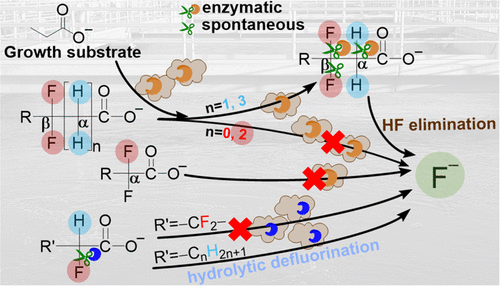当前位置:
X-MOL 学术
›
Environ. Sci. Technol. Lett.
›
论文详情
Our official English website, www.x-mol.net, welcomes your
feedback! (Note: you will need to create a separate account there.)
Structure-Specific Aerobic Defluorination of Short-Chain Fluorinated Carboxylic Acids by Activated Sludge Communities
Environmental Science & Technology Letters ( IF 8.9 ) Pub Date : 2021-07-26 , DOI: 10.1021/acs.estlett.1c00511 Shun Che 1 , Bosen Jin 2 , Zekun Liu 2 , Yaochun Yu 1 , Jinyong Liu 2 , Yujie Men 1
Environmental Science & Technology Letters ( IF 8.9 ) Pub Date : 2021-07-26 , DOI: 10.1021/acs.estlett.1c00511 Shun Che 1 , Bosen Jin 2 , Zekun Liu 2 , Yaochun Yu 1 , Jinyong Liu 2 , Yujie Men 1
Affiliation

|
Per- and polyfluoroalkyl substances (PFAS) are a large group of manmade chemicals that impose emerging environmental concerns. Among them, short-chain per- and polyfluorinated carboxylic acids represent an important subgroup used as building blocks of biologically active chemicals and functional materials. Some are also considered PFAS alternatives, and some could be byproducts of the physicochemical treatment of PFAS. However, little is known about the environmental fate of short-chain fluorinated carboxylic acids (FCAs) and their defluorination/transformation by microorganisms. To fill the knowledge gap, we investigated the structure–reactivity relationships in the aerobic defluorination of C3–C5 FCAs by activated sludge communities. Four structures exhibited greater than 20% defluorination, with 3,3,3-trifluoropropionic acid being almost completely defluorinated. We further analyzed the defluorination/transformation pathways and inferred the structures susceptible to aerobic microbial defluorination. We also demonstrated that the defluorination was via cometabolism. The findings advance the fundamental understanding of aerobic microbial defluorination and help assess the environmental fate of PFAS. Since some short-chain PFAS, such as 3,3,3-trifluoropropionic acid, are the incomplete defluorination byproducts of advanced reduction processes, their defluorination by activated sludge communities sheds light on the development of cost-effective chemical–biological PFAS treatment train systems.
中文翻译:

活性污泥群落对短链氟化羧酸的结构特异性好氧脱氟
全氟烷基物质和多氟烷基物质 (PFAS) 是一大类人造化学品,会引起新出现的环境问题。其中,短链全氟和多氟羧酸代表了一个重要的亚组,用作生物活性化学品和功能材料的组成部分。有些也被认为是 PFAS 的替代品,有些可能是 PFAS 物理化学处理的副产品。然而,人们对短链氟化羧酸 (FCA) 的环境归宿及其微生物脱氟/转化知之甚少。为了填补知识空白,我们研究了 C 3 -C 5好氧脱氟中的结构-反应性关系活性污泥群落的 FCA。四种结构表现出大于 20% 的脱氟,其中 3,3,3-三氟丙酸几乎完全脱氟。我们进一步分析了脱氟/转化途径,并推断出易受好氧微生物脱氟影响的结构。我们还证明了脱氟是通过共代谢进行的。这些发现促进了对好氧微生物脱氟的基本认识,并有助于评估 PFAS 的环境归宿。由于一些短链 PFAS,如 3,3,3-三氟丙酸,是先进还原工艺的不完全脱氟副产品,因此活性污泥群落对它们的脱氟为开发具有成本效益的化学-生物 PFAS 处理系统提供了启示.
更新日期:2021-08-10
中文翻译:

活性污泥群落对短链氟化羧酸的结构特异性好氧脱氟
全氟烷基物质和多氟烷基物质 (PFAS) 是一大类人造化学品,会引起新出现的环境问题。其中,短链全氟和多氟羧酸代表了一个重要的亚组,用作生物活性化学品和功能材料的组成部分。有些也被认为是 PFAS 的替代品,有些可能是 PFAS 物理化学处理的副产品。然而,人们对短链氟化羧酸 (FCA) 的环境归宿及其微生物脱氟/转化知之甚少。为了填补知识空白,我们研究了 C 3 -C 5好氧脱氟中的结构-反应性关系活性污泥群落的 FCA。四种结构表现出大于 20% 的脱氟,其中 3,3,3-三氟丙酸几乎完全脱氟。我们进一步分析了脱氟/转化途径,并推断出易受好氧微生物脱氟影响的结构。我们还证明了脱氟是通过共代谢进行的。这些发现促进了对好氧微生物脱氟的基本认识,并有助于评估 PFAS 的环境归宿。由于一些短链 PFAS,如 3,3,3-三氟丙酸,是先进还原工艺的不完全脱氟副产品,因此活性污泥群落对它们的脱氟为开发具有成本效益的化学-生物 PFAS 处理系统提供了启示.









































 京公网安备 11010802027423号
京公网安备 11010802027423号